SC Rewind: 70 Jugs And Counting
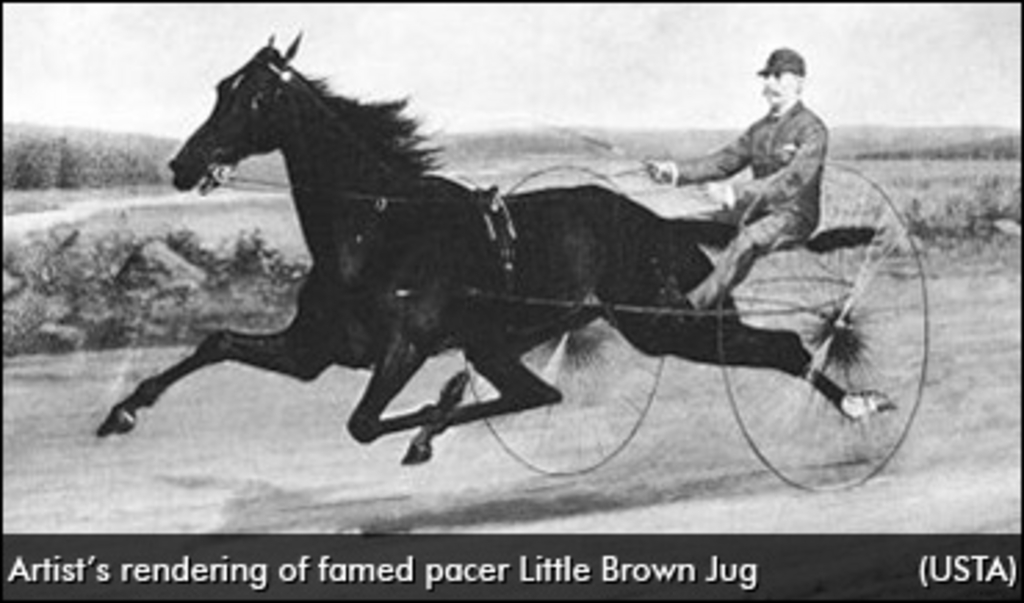
 In this week's edition of Rewind Robert Smith traces the long and interesting history of the famous Little Brown Jug Race which this Thursday is about to hold its 70th renewal.
In this week's edition of Rewind Robert Smith traces the long and interesting history of the famous Little Brown Jug Race which this Thursday is about to hold its 70th renewal.
A number of vintage photographs depicting the first Jug as well as others from the early years form an important part of this Rewind.
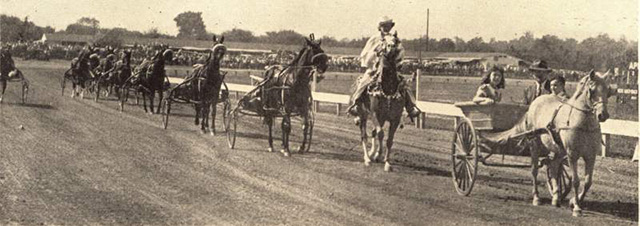
The horses parade to the post in the inaugural Little Brown Jug in 1946
Way back on the afternoon of September 18, 1946 a group of individuals at the then small city of Delaware, Ohio watched their dream turn into a reality. This group, headed by two local gentlemen -- one an attorney named Joe Neville and the other the managing editor of The Delaware Gazette named Henry C. "Hank" Thomson -- were all elated. Their idea of a great event for three-year-old pacers was long in the making and was now on its way. Certainly no one could have ever envisioned what a great annual event it would become.
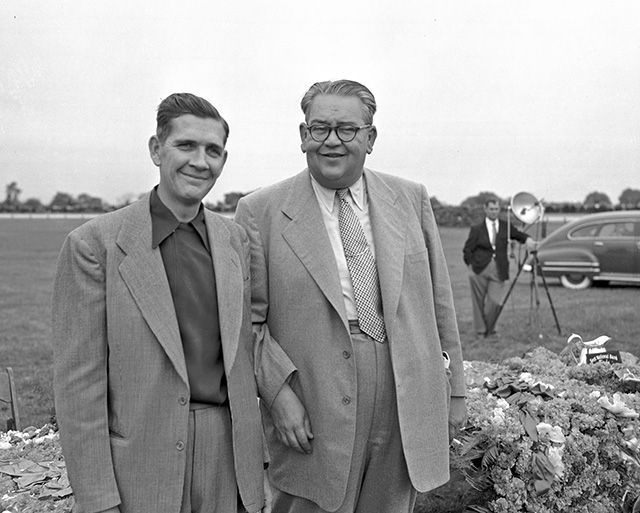
The two men shown here were the founders of The LBJ. Pictured during Jug day on the left is Hank Thomson and Joe Neville
While the first actual Little Brown Jug was held in 1946, much more work and planning preceded this day including two Derby Trials in 1944 and 1945. One of the major items that had to be accomplished was the naming of the race. This was reportedly accomplished by running a newspaper contest, asking for suggestions from the general public. Apparently some 4,000 entries or suggestions were offered and from them was chosen the now famous name.
Legend has it that besides the popular old song Little Brown Jug, there also once existed a horse named Little Brown Jug. He was bred in Tennessee and first owned by a farmer who used him as a plow horse on weekdays and on Sundays he transported the family to Church. It seems that this gentleman owed a debt of $80 and to satisfy his obligation, the horse was shipped to the north. His new owner immediately noticed his pacing ability and decided to train him for racing purposes. So Little Brown Jug became a race horse and in 1881 established a new world record of 2:11 3/4 pacing.
Accounts of the first Little Brown Jug day reported that by mid-morning the parking areas were completely filled. "They had come to Delaware from as far away as Florida, Canada, New York and California and just about everywhere in between. Unofficial gate estimates put the swarm of Little Brown Jug enthusiasts at 27,000. The weather was ideal and the field of top three-year-old pacers gave the huge crowd its money's worth and more!"
From the very beginning the race was a community affair. Leading up to the first Jug week which began on Tuesday and ended on Saturday, the entire population of Delaware were on board. Every street in the city displayed banners. Pennants with a Little Brown Jug emblazoned on them hung on wires that stretched across the streets. Shop windows, private homes, costume jewellers, everyone great and small joined in the promotion. In his Hoof Beats write-up of the first Little Brown Jug noted writer of the day "Buck" O'Neill wrote the following. "Crowd reaction is the unfailing test of success, and never has this reporter noted a response more spontaneous than that of the crowd to the playing of The Little Brown Jug as the field paraded to the post...Joe Neville knew his job was completed."
The first Jug drew a field of nine starters and carried a purse of $35,358. As the day began, a bit of drama began to unfold on the backstretch. One of the sport's best known and most accomplished reinsman had a huge opportunity to add the winning of the inaugural of this race to his list of accomplishments. That man was Sep Palin, known for many great triumphs and lofty accomplishments. On this day he had the great Billy Direct-sired pacing colt Ensign Hanover honed and ready for action. After all he was the man who was behind the great trotter Greyhound in virtually all of his lifetime starts.
Troubled by a rather serious respiratory ailment and attempting to shake off the effects of a racing accident at Shelbyville, he was still up for the challenge...or so he thought. After warming up Ensign Hanover for the Jug's first heat, he soon realized he would be unable to stand the arduous task of possibly racing in four grueling heats. He approached Joe McGraw, the presiding Judge and was granted permission to name a substitute driver.
His choice was a local horseman named Wayne "Curly" Smart. He was well known on the national scene and "loved" by the locals. As it turned out, the decision proved to be a wise one. Smart drove the colt to perfection, saving the best for last as he scored a convincing victory in the three-horse race off. He was never worse than second in the four heats. Mr. Smart was well named; he soon became synonymous with the Jug's success. In the years that followed, he drove in many more Jug starts, and was the winner of the 1952 edition behind Meadow Rice.
Mr. Smart was also instrumental in making the Delaware County oval the marvellous racing strip it became when he was the track superintendent. It was not unusual for him on Jug day to jump on a tractor and fine tune the track while still wearing his racing silks. The condition of the track on the big day has always been of paramount importance. In 1948 The National Guard was called in to use flamethrowers in an attempt to dry the soggy track. The experiment was a failure but thankfully the sun made a timely appearance and the track dried out in time to hold the annual event.
The intimate setting of the Jug in many ways has changed little in the past nearly 70 years. The originators wanted to establish the race as a pacing counterpart to the fabled Hambletonian, which already had a 20 year history. They also wanted it to be contested over a half-mile oval, like the ones that had popularized the sport across the land. I believe they also were desirous of keeping the rural smallish-town feeling. The race has gained in stature over the years and risen in popularity despite so many changes in the sport and indeed the world. Year after year it remains perhaps the most traditional and coveted prize in the world for pacers.
"The Little Brown Jug is a part of Americana. And it shall ever remain so." - A quote from The Little Brown Jug Society website.
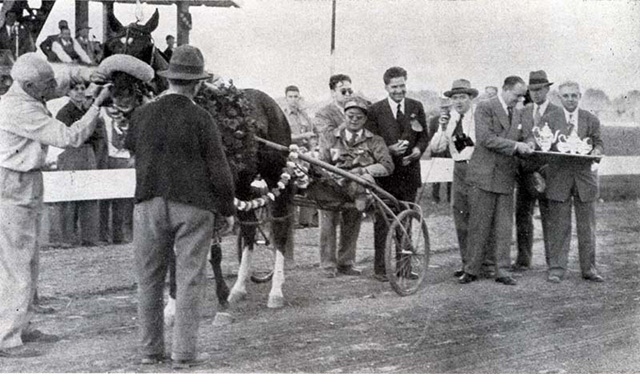
The winner's circle on September 18, 1946. Ensign Hanover stands patiently as Little Brown Jug officials -- headed by Karl Record and Ohio Governor Frank Lausche -- award the first ever silverware to the owners representing Castleton Farms of Lexington, Kentucky. Chosen just before the race due to illness of the horse's regular pilot Sep Palin, 42-year-old driver Wayne "Curly" Smart smiles his approval. It is interesting to note that Mr. Smart is wearing a necktie under his silks which was a common practice back then.
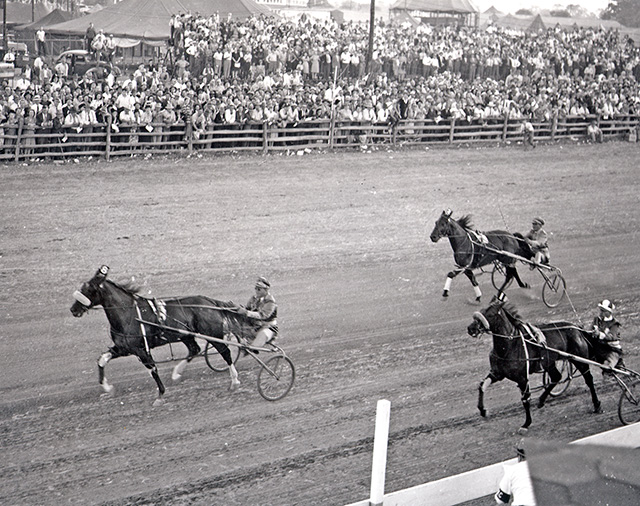
Ensign Hanover and driver Curly Smart reach the wire in 2:07 1/2 ahead of Royal Chief and His Lady to become the first winner of the famed Little Brown Jug, held September 18, 1946. This was a three-horse race off of the three heat winners, thus the fourth mile of the long afternoon. A portion of the huge crowd estimated at 27,000 is visible in the background.
Shown below are a number of vintage photos from the very early years of The Little Brown Jug held annually at Delaware, Ohio
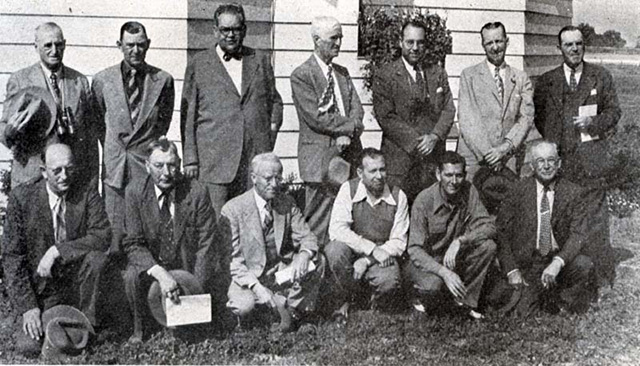
The officials at Delaware gather on the day of the first LBJ. Front row (L-R) Frank Riley, L I Sharp, Fred Butler, Irv Carlisle, Hank Thomson, Wayne Groves. Back row (L-R) Joe McGraw, Riley Couch (starter),Joe Neville, Tom Gahagan, Ed Keller, Bob Jewell, Earl Coburn
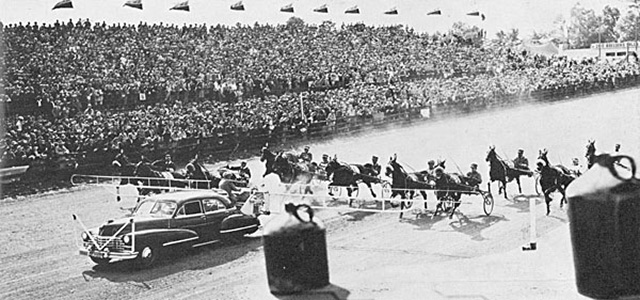
The 1950 field shows a huge crowd in front of the old rail fence with the traditional jugs visible in the judge's stand. The eventual winner was Dudley Hanover driven by Delvin Miller for The Hayes Fair Acres stable of DuQuoin, Ill. This was one of the first mobile starting gates to be used at Delaware.
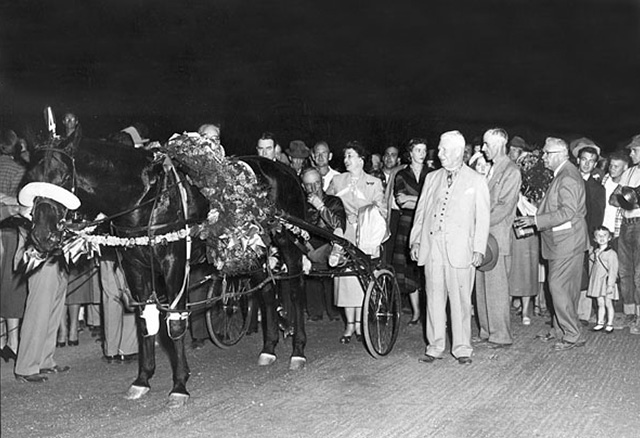
In 1953 the shadows of late afternoon had overtaken the Delaware County Fairgrounds by the time Keystoner and driver Frank Ervin could appear in the winner's circle and claim that year's Jug for owner George Tipling. Both men's and ladies attire was slightly different back then.
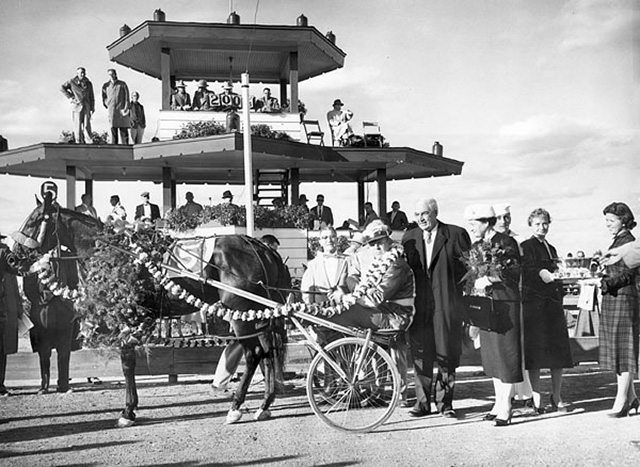
In 1956 John Simpson Sr. is shown with that year's winner Noble Adios and owners Mr. and Mrs. Paul Wixom. The race time of 2:00.4 is visible at the top of the tiered judges stand which was slightly off the race record of 2:00 set in 1951 by Tar Heel and Del Cameron. This was Simpson's first Jug win but he went on to win the race three times in a five-year span also scoring with Torpid and Bullet Hanover.
(My thanks to Jay Wolf of the LBJ Publicity Dept., and also to Don Daniels for supplying a number of great photographs and other material. All photographs displayed courtesy of U.S.T.A.)

